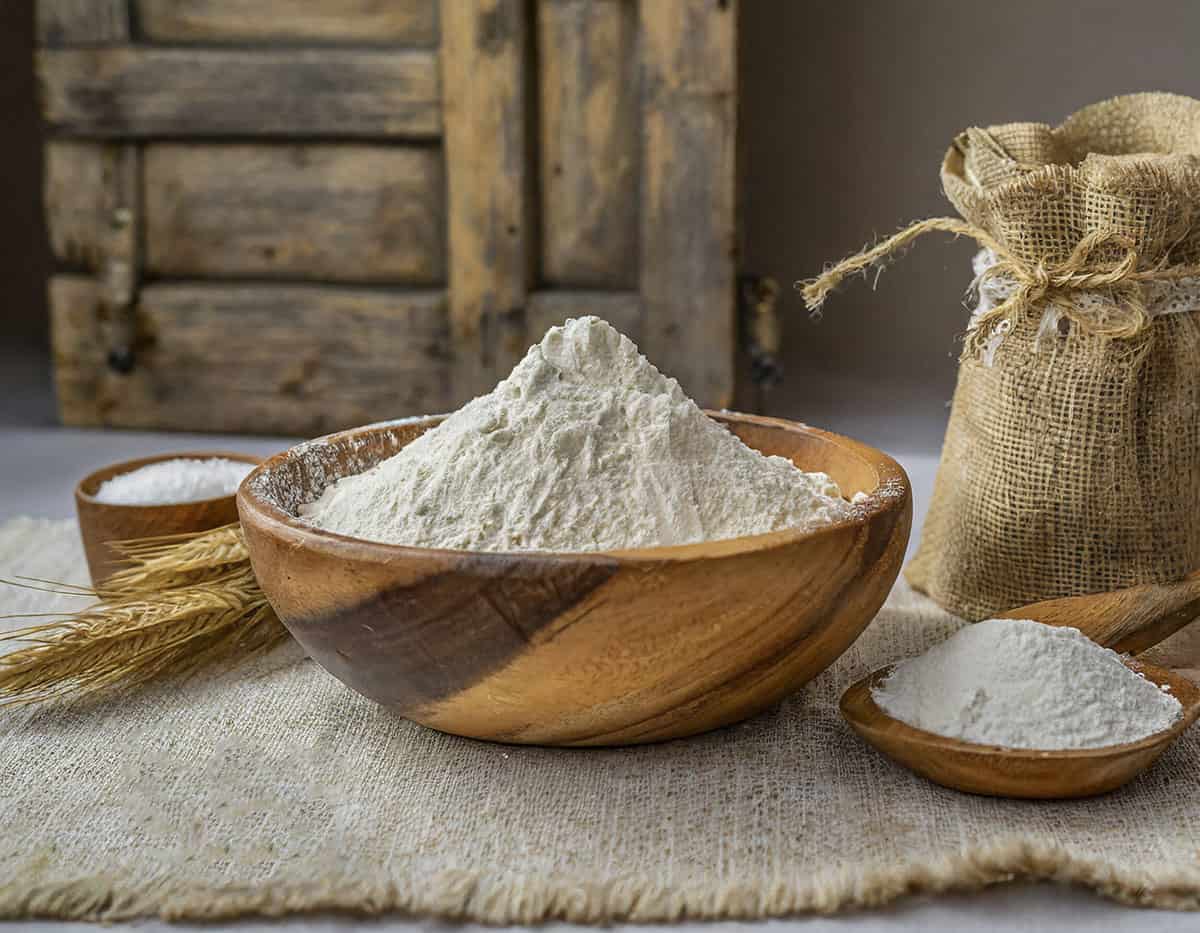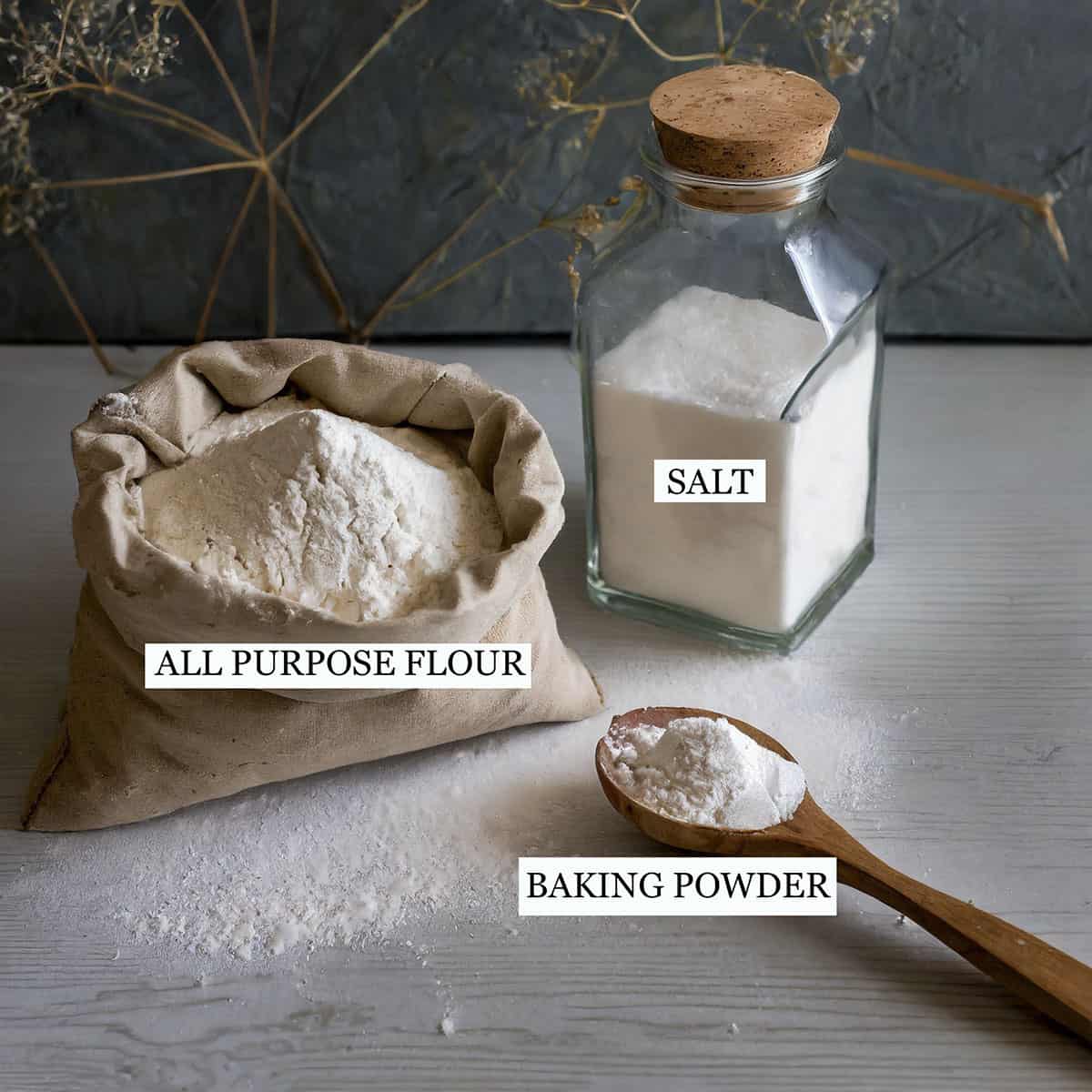3 Ingredient Homemade Self-Rising Flour
This post may contain affiliate links. If you make a purchase after clicking a link, I may earn a small commission AT NO COST TO YOU. As an Amazon Affiliate, I earn from qualifying purchases.
Creating your homemade self-rising flour is so simple and yet I’ll bet that once you make your own, you’ll never go back to buying it at the store.
This staple ingredient, used in all types of recipes like biscuits, pancakes, and quick breads, relies on a blend of all-purpose flour, baking powder, and salt.
The secret to exceptional self-rising flour lies in the freshness of these three components, which can bring the quality of your baked goods to a whole new level.

Use Fresh Ingredients!
All-Purpose Flour: This is the main base of the self-rising flour. Its versatility and neutral flavor make it ideal for many baked items. Using the freshest flour you can get your hands on ensures your self-rising flour has a good protein content, which is crucial for texture and structure in baking.
Baking Powder: Probably the most important element to have as fresh as possible because it’s responsible for the rise in your baked goods. Using old or stale baking powder can lose its potency and could result in flat, dense baked items.
Salt is added for flavor balance. It enhances the overall taste of your baked goods, making the sweetness, butteriness, or any other flavor more pronounced. The amount of salt used in this ratio is perfect, and if the recipe you’re using calls for additional salt, feel free to omit it as usually the salt in this flour mixture makes up for it.

How to Make Self-Rising Flour
To prepare your own self-rising flour at home, follow this simple recipe:
- 1 cup of all-purpose flour
- 1 1/2 teaspoons of baking powder
- 1/2 teaspoon of salt
Whisk these ingredients together until well combined. This mixture yields 1 cup of self-rising flour, ready to be used in your favorite recipes.
***Note: For every cup of flour you need for your recipe, use the proportions above. If you need more than one cup, easily double or triple the recipe to accommodate your recipe. It’s not a bad idea to make up a few cups of your homemade self-rising flour so that even if you need a cup and half of it, you have it premade, ready to measure out and add to your recipe.

What Kind Of Things Can I Make With Self Rising Flour?
You can make SO many delicious things with this homemade flour!
- 4 Ingredient Banana Bread
- 3 Ingredient Buttery Naan Bread
- 2 Ingredient Yogurt Bread
- 2 Ingredient Air Fryer Bagels
- 2 Ingredient Dinner Rolls

Questions You Might Have
1. Can I use whole wheat flour to make self-rising flour?
Yes, you can substitute all-purpose flour with whole wheat flour to make a whole wheat self-rising flour. Keep in mind that whole wheat flour has a denser texture and a stronger flavor, which may affect the outcome of your baked goods.
2. Can self-rising flour be used to make gravy?
Yes, self-rising flour can be used in gravy to thicken it, (the thickening agent being the flour), but it will also introduce leavening agents and salt, so adjust other ingredients accordingly.
3. Is Bisquick self-rising flour?
No, Bisquick is not just self-rising flour; it also contains fats, salt, and other leavening agents. It’s a baking mix designed for a broader range of recipes, not a direct substitute for self-rising flour.
4. Can I use self-rising flour to make pancakes?
Absolutely! Self-rising flour is perfect for pancakes, giving them a fluffy texture without additional leavening agents.
5. Can I use baking soda instead of baking powder to make self-rising flour?
No, because baking soda requires an acid to activate. Since self-rising flour typically doesn’t contain acidic ingredients, baking powder, which contains both an acid and a base, is necessary for the desired leavening effect.
6. Can I use almond flour to make self-rising flour?
Yes, you can mix almond flour with baking powder and salt, but you won’t have the same result as using regular all-purpose flour. APF has gluten which helps the baked good rise. Almond flour doesn’t have gluten, so you won’t get the same exact result. It’s best used in recipes specifically designed for gluten-free flour.
7. Can I use cornstarch instead of baking powder to make self-rising flour?
No, cornstarch can’t be subbed in place of baking powder. Cornstarch is a thickener while baking powder is a leavening agent.
8. How long will homemade self-rising flour stay good for?
Homemade self-rising flour will stay fresh for about six months if stored in a cool, dry place. Its shelf life mainly depends on the freshness of the ingredients used. You can also freeze the SRF to extend its shelf life. Just remember to bring the flour mixture to room temperature before you start your recipe.
9. Can I use self-rising flour in my cornbread recipe?
Yes, you can use self-rising flour in cornbread recipes. It can simplify the recipe by eliminating the need for additional leavening agents and salt but it’s always a good idea to check the amounts called for in the recipe.
While it’s super easy to simply buy premade self rising flour at the store, knowing how to make it yourself can get you out of a pickle if you’re in the middle of making your baked goods and you don’t have any on hand. Also, you can control the freshness of all the ingredients, and this simple adjustment can make a big difference in the quality of your finished product, proving that sometimes, the best results come from going back to the basics.
I hope you found this article and recipe helpful! Thanks for stopping by Eazy Grub and I hope to see you next time!
~Joanne
Print this recipe card and save it for future reference:
3 Ingredient Homemade Self-Rising Flour

Homemade self rising flour is not only easy to make, but it ensures you use the freshest ingredients possible for your baked goods.
Ingredients
- 1 cup All purpose Flour
- 1 1/2 teaspoons Baking Powder
- 1/2 teaspoon Salt
Instructions
- Add all the ingredients to a bowl and whisk to incorporate.
- Use as you would in any recipe that calls for self-rising flour.
- Store in an air-tight container in cool place.
Notes
You can also freeze this self rising flour recipe to extend it's shelf life.
The recipe is easily doubled or tripled to use in your recipes.
Nutrition Information
Yield
1Serving Size
1Amount Per Serving Calories 459Total Fat 1gSaturated Fat 0gTrans Fat 0gUnsaturated Fat 1gCholesterol 0mgSodium 1791mgCarbohydrates 97gFiber 3gSugar 0gProtein 13g
All nutritional information is based on third party calculations and is only an estimate. Each recipe and nutritional value will vary depending on the brands used, measuring methods and portion sizes per household.
